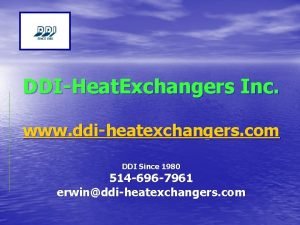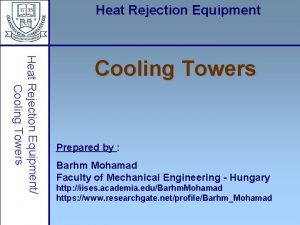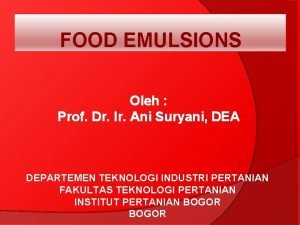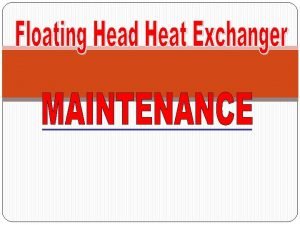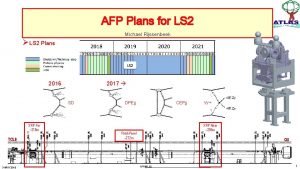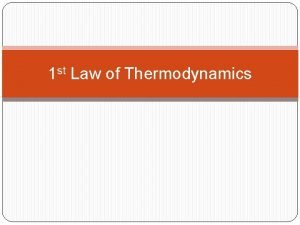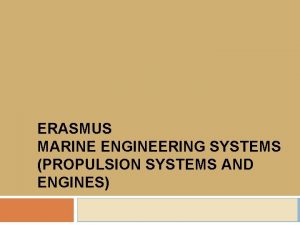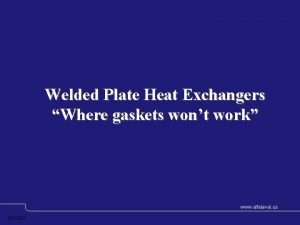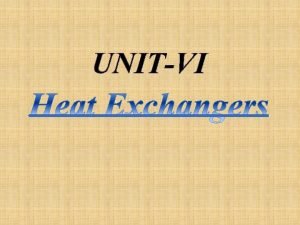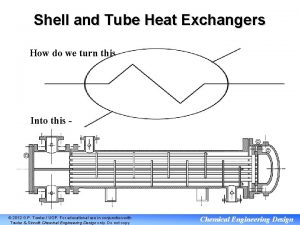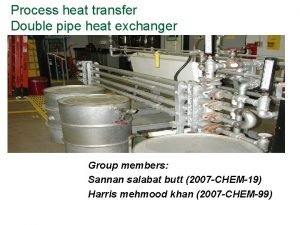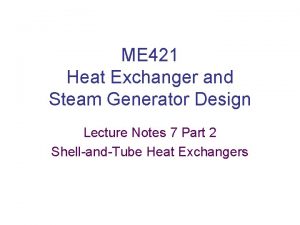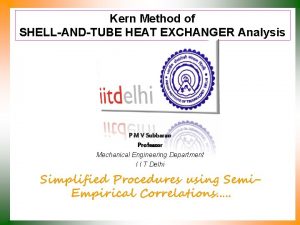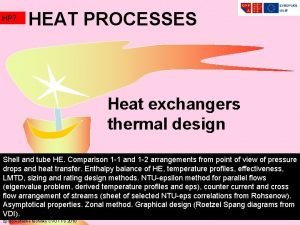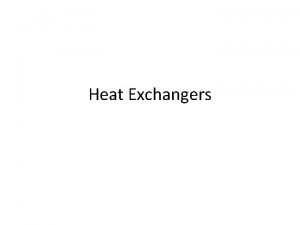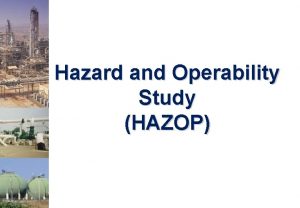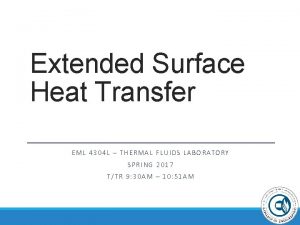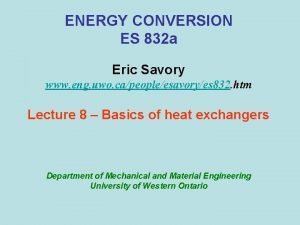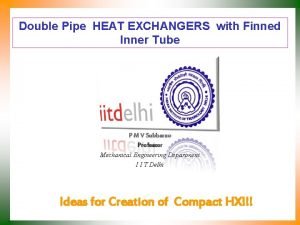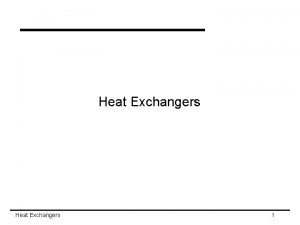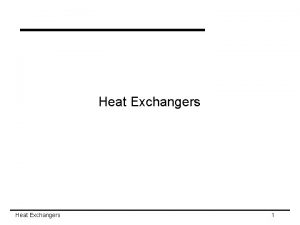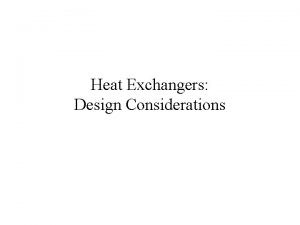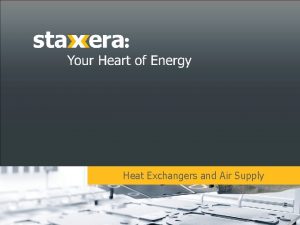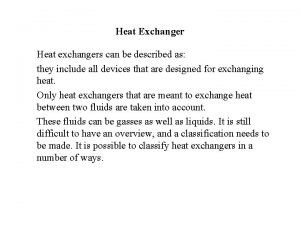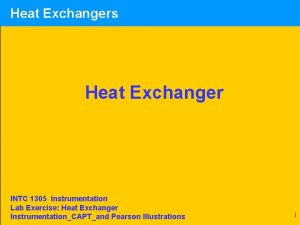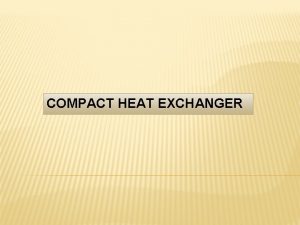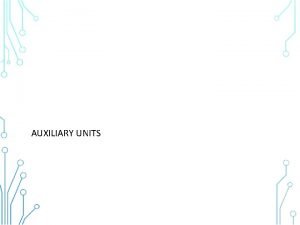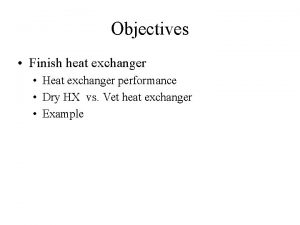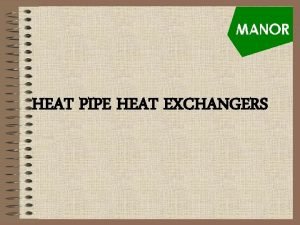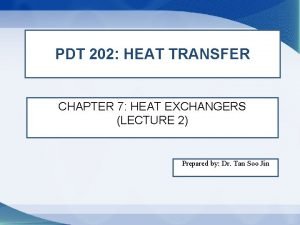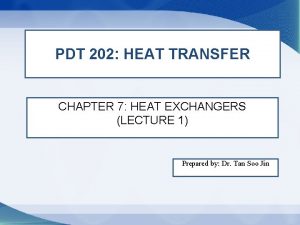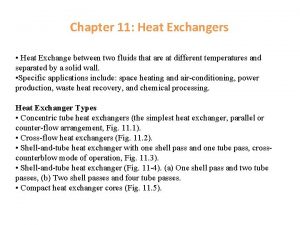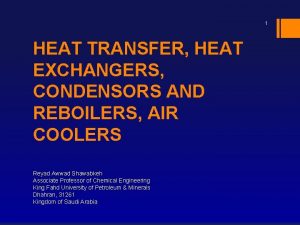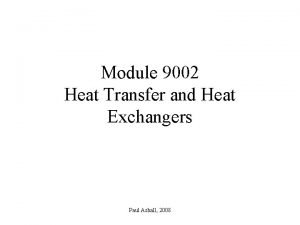Chapter 11 Heat Exchangers Types Heat Exchanger Types





















- Slides: 21

Chapter 11 – Heat Exchangers

Types Heat Exchanger Types Heat exchangers are ubiquitous in energy conversion and utilization. They involve heat exchange between two fluids separated by a solid and encompass a wide range of flow configurations. 1. 2. 3. 4. Concentric-Tube Heat Exchangers Cross-flow Heat Exchangers Shell-and-Tube Heat Exchangers Compact Heat Exchangers Considerations • Type of fluid(s) involved (liquid, two-phase, gaseous) • Available space • Operating pressures • Initial cost and operating (maintenance) costs

Types 1. Concentric-Tube Heat Exchangers Parallel Flow Counterflow Ø Simplest configuration. Ø Superior performance associated with counter flow.

Types (cont. ) 2. Cross-flow Heat Exchangers Finned-Both Fluids Unmixed Unfinned-One Fluid Mixed the Other Unmixed Ø For cross-flow over the tubes, fluid motion, and hence mixing, in the transverse direction (y) is prevented for the finned tubes, but occurs for the unfinned condition. Ø Heat exchanger performance is influenced by mixing. Ø Pressed-on plates can act like fins, but loose plates only prevent y-direction mixing Ø Tubes can be in parallel, or in series

Types (cont. ) 3. Shell-and-Tube Heat Exchangers One Shell Pass and One Tube Pass Ø Baffles are used to establish a cross-flow and to induce turbulent mixing of the shell-side fluid, both of which enhance convection. Ø The number of tube and shell passes may be varied, e. g. : One Shell Pass, Two Tube Passes Two Shell Passes, Four Tube Passes

Types (cont. ) Shell-and-Tube Heat Exchangers Common Problems Ø Corrosion and fouling are always a concern for heat exchangers - This image shows fouling on the tube side. - Can equally have fouling on the shell side. Ø Mechanical breakage of a tube (freezing, fatigue, etc. ) can be difficult to repair - Plug tube (block leak on both sides) - Replace tub (very high labor costs)

Types (cont. ) 4. Compact Heat Exchangers Ø Widely used to achieve large heat rates per unit volume, particularly when one or both fluids is a gas. Ø Characterized by large heat transfer surface areas per unit volume, small flow passages, and laminar flow. (b) Fin-tube (circular tubes, continuous plate fins) (a) Fin-tube (flat tubes, continuous plate fins) (d) Plate-fin (single pass) (c) Fin-tube (circular tubes, circular fins) (e) Plate-fin (multipass)

Overall Coefficient Overall Heat Transfer Coefficient – U or UA In a non-mixing heat exchanger could be modeled similar to a plane wall where there is: 1. Convection between the cold fluid to the cold side of the intermediate solid 2. Surface resistance (due to fouling) on the cold side of the intermediate solid 3. Conduction through the intermediate solid 4. Surface resistance (due to fouling) on the hot side of the intermediate solid 5. Convection between the hot side of the intermediate solid to the hot fluid • With subscripts c and h used to designate the cold and hot fluids, respectively, the most general expression for the overall coefficient is: However, we can also simplify this by saying the heat (or heat rate) lost by the hot side is equal to the heat (or heat rate) gained by the cold side. Mathematically this is:

Overall Coefficient (cont. ) Terms in the Thermal Resistance Equation – U or UA Ø Ø Ø

Transition Calculating UA - Concentric Tube Example

Transition Once you know UA (calculated or provided) Calculate Heat Rate

LMTD Method Ellem. Teedee – Concentric Tube - The Log Mean Temperature Difference (LMTD) Method • A form of Newton’s law of cooling may be applied to heat exchangers by using a log-mean value of the temperature difference between the two fluids: (11. 14) (11. 15)

LMTD Method Ellem. Teedee – Concentric Tube - The Log Mean Temperature Difference (LMTD) Method Evaluation of depends on the heat exchanger type. • Counter-Flow Heat Exchanger: 1 2

LMTD Method (cont. ) Ellem. Teedee – Concentric Tube - The Log Mean Temperature Difference (LMTD) Method • Parallel-Flow Heat Exchanger: Occasionally you are more interested in controlling outlet temperature than you are with magnitude of heat transfer. If this is the case parallel-flow is the correct choice.

LMTD Method (cont. ) Concentric Tube: Counter-Flow vs. Parallel-Flow Ø Note that Tc, o cannot exceed Th, o for a PF HX, but can do so for a CF HX. Ø For equivalent values of UA and inlet temperatures, Alternate form of LMTD Calculation

Energy Balance Overall Energy Balance • Application to the hot (h) and cold (c) fluids: • Assume negligible heat transfer between the exchanger and its surroundings and negligible potential and kinetic energy changes for each fluid. • Assuming no liquid-vapor phase change and constant specific heats,

Special Conditions Special Operating Conditions Ø Case (a): Ch>>Cc or h is a condensing vapor – Negligible or no change in Ø Case (b): Cc>>Ch or c is an evaporating liquid – Negligible or no change in Ø Case (c): Ch=Cc. –

Transition Heat Exchanger Effectiveness

Problem: Ocean Thermal Energy Conversion Problem 11 S. 8: Design of a two-pass, shell-and-tube heat exchanger to supply vapor for the turbine of an ocean thermal energy conversion system based on a standard (Rankine) power cycle. The power cycle is to generate 2 MWe at an efficiency of 3%. Ocean water enters the tubes of the exchanger at 300 K, and its desired outlet temperature is 292 K. The working fluid of the power cycle is evaporated in the shell of the exchanger at its phase change temperature of 290 K, and the overall heat transfer coefficient is known. SCHEMATIC:

Problem: Ocean Thermal Energy Conversion (cont. ) <

Problem: Ocean Thermal Energy Conversion (cont. ) <
 Ddi heat exchangers
Ddi heat exchangers Twisted tube heat exchanger
Twisted tube heat exchanger Young heat exchangers
Young heat exchangers Scraped surface heat exchangers in food industry
Scraped surface heat exchangers in food industry Shell side hydrotest of heat exchanger
Shell side hydrotest of heat exchanger Rce heat exchangers
Rce heat exchangers Ddi heat exchangers
Ddi heat exchangers Nozzle and diffuser
Nozzle and diffuser Aes heat exchanger
Aes heat exchanger Types of heat exchanger on board ship
Types of heat exchanger on board ship Compabloc exchanger
Compabloc exchanger Single pass tubular heater
Single pass tubular heater Duty of heat exchanger
Duty of heat exchanger Single pipe heat exchanger
Single pipe heat exchanger Steam generator heat exchanger
Steam generator heat exchanger Kern's method
Kern's method Cross flow heat exchanger
Cross flow heat exchanger Tubular heat exchanger
Tubular heat exchanger Hazop heat exchanger example
Hazop heat exchanger example Extended surface heat exchanger
Extended surface heat exchanger Lmtd heat exchanger formula
Lmtd heat exchanger formula Pipe
Pipe
